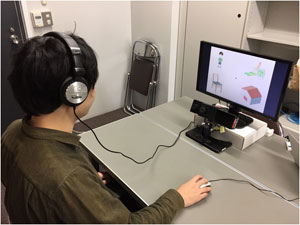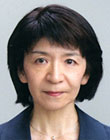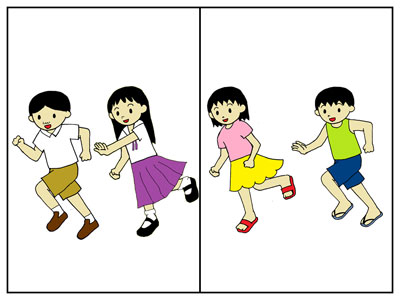Top>Research>On Learning a Second Language, Acquiring a Heritage Language, and Becoming Bilingual
 Index
Index
On Learning a Second Language, Acquiring a Heritage Language, and Becoming Bilingual
Makiko Hirakawa
Professor, Faculty of Letters, Chuo University
Areas of Specialization: Linguistics, First/Second Language Acquisition, English Language Education
The number of children on the planet being raised bilingual is thought to be about the same as the number of children being raised monolingual. Investigating the language abilities of people who speak two or more languages is sure to contribute to our understanding about the possibilities and the limits of language acquisition among human beings. This article gives an overview of some of the latest research undertaken in the Hirakawa Lab.
1. Heritage language and second language among foreign residents in Japan
Our research team investigates various characteristics of linguistic knowledge among Chinese and Filipino children and parents who have settled in Japan. According to statistics provided by the Ministry of Justice, the number of mid-term to long-term foreign residents in Japan exceeded 2.23 million as of December 2015. In particular, there are large numbers of residents from China (approx. 660,000) and from the Philippines (approx. 230,000). These numbers are expected to continue to increase with continuing globalization. However, when compared to western nations, Japan still has a long way to go to support retention of heritage languages as well as acquisition of Japanese as a second language by foreign residents. Currently, there is a lack of theoretical and empirical research related to the acquisition of heritage languages in Japan and to second language Japanese among foreign residents, including among young learners. In this context, the term heritage language refers mainly to a language passed down from parents to children within the home. Children who speak a heritage language grow up using the majority language of society outside of the home. Therefore, in many cases, the level of proficiency in the heritage language does not typically reach that of their parents. The majority of children targeted by our research speak either Chinese or Tagalog (Filipino language) with their family at home and use Japanese at school and elsewhere outside the home. Our research takes a linguistic approach to examine how retention of a heritage language is affected by limited language usage in the home environment, and how the heritage language affects the acquisition of Japanese as a second language.
For example, word order in a sentence with a subject, object, and verb differs in Japanese, Chinese, and Tagalog. Tagalog has some complicated grammatical properties, so this article will use examples of relative clauses in Japanese, Chinese, and English to illustrate the relevant points. Word order in Japanese is “subject-object-verb,” while both Chinese and English use the order “subject-verb-object.” However, when modifying a noun with a relative clause, Japanese and Chinese use the word order “relative clause-noun,” while English uses the reverse, “noun-relative clause.” Thus, Chinese language patterns combine elements of both English and Japanese.
- Japanese:
- [女の子を 追いかける]男の子
- Chinese:
- [追 女孩子 的 ]男孩子
- English:
- the boy [who chases the girl]
It is predicted that these differences among languages result in bilinguals comprehending and producing speech of one language in a manner that is affected by the other language they know. By using experimental methods developed by our overseas research partner Dr. Nozomi Tanaka (Indiana University, USA), we are investigating whether the heritage languages of Chinese and Tagalog speakers in Japan might be affected by their knowledge of Japanese as a second language, and vice versa. Our research has revealed areas where such effects exist and areas where there appears to be no effect.[3] [4]
2. What is the word order of adjectives in English?
As mentioned earlier, the environment for heritage language use is primarily restricted to the home. Meanwhile, Japanese people essentially learn English in a classroom environment, so the environment for their English use is also restricted. Research has been conducted that compares acquisition in such restricted environments to acquisition abroad through foreign study in an English-speaking country where there are extensive opportunities for being exposed to English. The focus of the research was the word order of adjectives. For example, assume that there is a round table made out of glass and looks very nice. When described in English, which of the following sentences sounds natural in English?

(1)a nice round glass table
(2)a round nice glass table
(3)a nice glass round table
Pattern (1) is natural English. Patterns (2) and (3) are unnatural and are not normally accepted by native English speakers. In other words, there are rules for adjective word order in English. In contrast, adjectives in Japanese have a relatively free word order. “Nice” is an adjective expressing evaluation; “round” is a shape; and “glass” refers to a substance or material. When using multiple adjectives as attributes, the following word order is proposed: evaluation > size > weight > old/new > shape > color > material + noun.[5] Languages can be divided into two types: languages that have strict rules for adjective word order (such as English) and languages in which adjective word order is relatively free (such as Japanese). When investigating whether native Japanese speakers learning English possess knowledge related to adjective word order, we found that they often accept expressions with adjective word orders unacceptable to native speakers of English (in the above example, (2) or (3) was mistakenly selected). Next, we carried out an experiment in which explicit instruction was given to Japanese university students to determine whether or not knowledge of adjective word order in English could be acquired. After instructing students for 1 hour a week for 3 weeks, the average percentage of correct answers rose to 86% compared to 59% prior to instruction. The benefit of explicit instruction was clearly demonstrated.[6]
In this study, the same test was also given twice, at intervals of 5 to 6 weeks, to a group that did not receive instruction and to a group that participated in a 5-week intensive English language program in America but received no explicit instruction regarding adjective order. For the group that remained in Japan, no change was observed. Furthermore, for the group that studied in America, although there was a modest overall increase in the percentage of correct answers, no statistically significant increase was observed. Although the group that studied overseas was exposed to a large amount of natural English during homestays and in intensive English classes, it was not enough to acquire the correct word order for adjectives. This research demonstrated the effectiveness of explicit instruction in areas where there is difficulty in acquiring a second language. Furthermore, this learning effect persisted at the time of the second follow-up test (held 3 months later). However, long-term research is required to determine whether the knowledge has been permanently acquired by the learners.
3. Research using eye tracking: Exploring immediate language processing

In addition to the knowledge of language among native speakers and learners of a second language, another important research theme is to investigate how immediate language processing is performed. Research on second language acquisition has long been performed using various conventional methods (grammaticality judgment tests, etc.). In addition, a large amount of empirical research has recently begun to use psycholinguistic methods (timed reading experiments, tracking eye movements while listening, etc.). In particular, there is great interest in whether there are differences in processing speech between language learners and native speakers. Through cooperation with overseas researchers at the University of Hawaii, we are conducting research using a high-speed camera for recording eye-movement data with people in Hawaii who speak Japanese as a heritage language and use English in their daily life. By analyzing gaze patterns directed at pictures displayed on a computer screen while listening to samples of spoken language, it is possible to examine how acoustic stimuli are understood and processed. The reflexive pronoun jibun (自分) in Japanese is unique in that it indicates a subject but cannot indicate an object. Conversely, the corresponding English reflexive pronoun “himself/herself” can indicate either a subject or an object. For example, consider the Japanese sentence tencho ga kyaku ni mise no mae de jibun no shashin wo yorokonde ageta (the store owner happily gave a photograph of himself/herself to a customer in front of the store). In this example, jibun (himself/herself) indicates the tencho (store owner), not the kyaku (customer). Our research showed that upon hearing the phrase jibun no shashin, Japanese native speakers directed their gaze at the picture of the store owner, not to the picture of the customer. The next phase of this on-going research will be to determine whether heritage speakers of Japanese do the same. This research was supported by a KAKENHI grant (Grant-in-Aid for Scientific Research (B)).
This article has given an overview of three research projects. While focusing on structural differences among native languages, heritage languages, and second languages, our research team continues to carry out experimental studies involving the acquisition and use of linguistic knowledge. Based on the obtained research results, we will elucidate mechanisms involved in language acquisition and language processing. In the future, we seek to provide recommendations for effective language education methodologies and retention efforts for heritage languages.
- ^ Tanaka, N. (2016). An asymmetry in the acquisition of Tagalog relative clauses (Unpublished doctoral dissertation). University of Hawaiʻi at Mānoa, Honolulu, HI.
- ^ Tanaka, N., O’Grady, W., Deen, K., Kim, C.-E., Hattori, R., Bondoc, I. P. M., & Soriano, J. U. (2016). “Relative clause comprehension task." Nozomi Tanaka Collection. Kaipuleohone:
http://hdl.handle.net/10125/42194. Type: language description. Media: image. Access: public. Resource ID: NT1-003.
Type: language description. Media: image. Access: public. Resource ID: NT1-003. - ^ Makiko Hirakawa, Michiko Fukuda, Kazunori Suzuki, Jiang Yinshi (in printing) “Comprehension and Production of Relative Clauses in Chinese—Exploratory Research Targeting Chinese Heritage Language Speakers Who Reside in Japan” Gengo to Bunka Vol. 29; Language and Culture Research Institute, Graduate School of Language and Culture, Bunkyo University
- ^ Hirakawa, Makiko. (to appear). Tense and Aspect in L2 Japanese by Chinese-Speaking and Tagalog-Speaking Children. (Invited Symposium Paper of the 16th Annual International Conferene of the Japanese Society for Language Sciences). Studies in Language Sciences, 15.
- ^ Yukito Seta (1997) “Fundamentals of English Grammar” Hituzi Syobo.
- ^ Endo, M., Shibuya M., and Hirakawa, M. (2016). Explicit Instruction vs. Natural Exposure in L2 Acquisition of Adjective Ordering in English. In D. Stringer et al. (eds.), Proceedings of the 13th Generative Approaches to Second Language Acquisition Conference (GASLA 2015), (pp. 60—71). Somerville, MA: Cascadilla Proceedings Project.
(http://www.lingref.com/cpp/gasla/13/paper3275.pdf )
)
- Makiko Hirakawa
Professor, Faculty of Letters, Chuo University
Areas of Specialization: Linguistics, First/Second Language Acquisition, English Language Education - Makiko Hirakawa was born in Kanagawa Prefecture. She graduated from the Faculty of Liberal Arts, Tsuda College in 1983. She completed the Master's Program (M.A. in Linguistics) at McGill University (Canada) in 1989. She completed the Doctoral Program (Ph.D. in Linguistics) at McGill University (Canada) in 2000. She served as English instructor at Meikei Junior High School and High School, as full-time instructor, Assistant Professor, and Professor at the School of International Relations, Tokyo International University, and as Professor at the Faculty of Language and Literature, Bunkyo University. She assumed her current position in 2016. Her main written works include “Unaccusativity in Second Language Japanese and English” (sole author; Hituzi Syobo, 2003), “Kotoba no Omoshiro Jiten (Interesting Encyclopedia of Words)” (co-written; edited by Heizo Nakajima; Asakura Publishing, 2016) and more. From 2014 to 2016, she served as the principal investigator for the KAKENHI research project “Theoretical and Empirical Research on Cross-linguistic Effects in Heritage and Second Language Acquisition” (Grant-in-Aid for Scientific Research (B), Project No. 26284081).
- Research Activities as a Member of Research Fellowship for Young Scientists (DC1), Japan Society for the Promotion of Science (JSPS) Shuma Tsurumi
- Important Factors for Innovation in Payment Services Nobuhiko Sugiura
- Beyond the Concepts of Fellow Citizens and Foreigners— To Achieve SDGs Goal 10 “Reduce Inequality Within and Among Countries” Rika Lee
- Diary of Struggles in Cambodia Fumie Fukuoka
- How Can We Measure Learning Ability?
—Analysis of a Competency Self-Assessment Questionnaire— Yu Saito / Yoko Neha - The Making of the Movie Kirakira Megane










